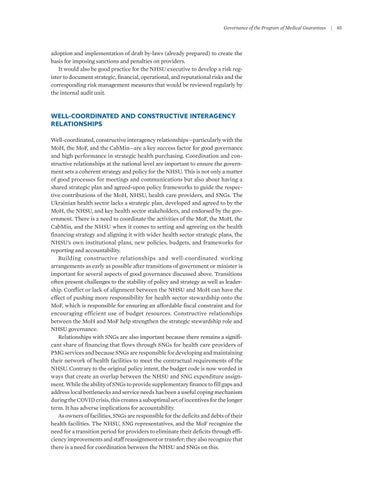Governance of the Program of Medical Guarantees
adoption and implementation of draft by-laws (already prepared) to create the basis for imposing sanctions and penalties on providers. It would also be good practice for the NHSU executive to develop a risk register to document strategic, financial, operational, and reputational risks and the corresponding risk management measures that would be reviewed regularly by the internal audit unit.
WELL-COORDINATED AND CONSTRUCTIVE INTERAGENCY RELATIONSHIPS Well-coordinated, constructive interagency relationships—particularly with the MoH, the MoF, and the CabMin—are a key success factor for good governance and high performance in strategic health purchasing. Coordination and constructive relationships at the national level are important to ensure the government sets a coherent strategy and policy for the NHSU. This is not only a matter of good processes for meetings and communications but also about having a shared strategic plan and agreed-upon policy frameworks to guide the respective contributions of the MoH, NHSU, health care providers, and SNGs. The Ukrainian health sector lacks a strategic plan, developed and agreed to by the MoH, the NHSU, and key health sector stakeholders, and endorsed by the government. There is a need to coordinate the activities of the MoF, the MoH, the CabMin, and the NHSU when it comes to setting and agreeing on the health financing strategy and aligning it with wider health sector strategic plans, the NHSU’s own institutional plans, new policies, budgets, and frameworks for reporting and accountability. Building constructive relationships and well-coordinated working arrangements as early as possible after transitions of government or minister is important for several aspects of good governance discussed above. Transitions often present challenges to the stability of policy and strategy as well as leadership. Conflict or lack of alignment between the NHSU and MoH can have the effect of pushing more responsibility for health sector stewardship onto the MoF, which is responsible for ensuring an affordable fiscal constraint and for encouraging efficient use of budget resources. Constructive relationships between the MoH and MoF help strengthen the strategic stewardship role and NHSU governance. Relationships with SNGs are also important because there remains a significant share of financing that flows through SNGs for health care providers of PMG services and because SNGs are responsible for developing and maintaining their network of health facilities to meet the contractual requirements of the NHSU. Contrary to the original policy intent, the budget code is now worded in ways that create an overlap between the NHSU and SNG expenditure assignment. While the ability of SNGs to provide supplementary finance to fill gaps and address local bottlenecks and service needs has been a useful coping mechanism during the COVID crisis, this creates a suboptimal set of incentives for the longer term. It has adverse implications for accountability. As owners of facilities, SNGs are responsible for the deficits and debts of their health facilities. The NHSU, SNG representatives, and the MoF recognize the need for a transition period for providers to eliminate their deficits through efficiency improvements and staff reassignment or transfer; they also recognize that there is a need for coordination between the NHSU and SNGs on this.
|
85

